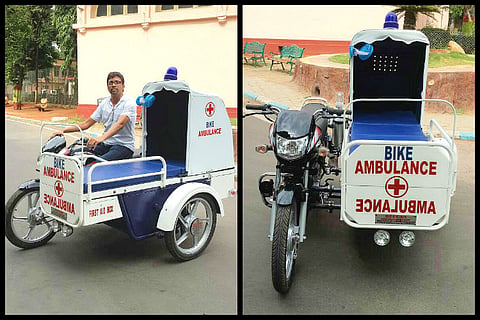

It’s a Sunday afternoon, but Mohammed Shahzore Khan seems to have little time to sit down and relax. The 43-year-old owner of a workshop for customised motorcycles in Nampally in Hyderabad is hard at work guiding two of his mechanics in modifying a Hero Honda Passion for its disabled owner.
“I live with bikes. I always wanted to create something which will help people in need,” says Mohammed. His creation: a motorcycle ambulance equipped with essential medical equipment, including an oxygen cylinder for patients in a serious condition.
Continuing his father’s legacy of making customised motorbikes especially for persons with physical disabilities, Khan and his team of 10 members customised a Hero HF Deluxe motorbike to attach a sidecar equipped with a fully functional ambulance unit.
“It is a mini ambulance that has all the facilities an ambulance normally provides. It has a stand for an oxygen cylinder, a shade over the bed, a small fan, a first-aid box and a stretcher,” Mohammed tells TNM.
The ambulance comes with enough room for a patient to lie down or sit inside the sidecar. The bottom portion of the ambulance is equipped with a foldable stretcher that can be used to transfer the patient into and out of the ambulance. The foldable top portion retracts easily to facilitate this. It also comes with stands fixed between the bike and the sidecar, which can hold IV lines and oxygen cylinders.
The idea came to Mohammed after he and his wife noticed several articles talking about the lack of availability of ambulances in several areas, which had forced people to carry patients on motorbikes or in push carts. What particularly moved Khan were cases in which poor patients couldn’t afford a full-fledged ambulance.
“Last year, I saw the news about Ramulu, who carried his wife’s dead body in a pushcart, travelling all the way till Vikarabad town in Telangana, as he did not have money to arrange for an ambulance. I wanted to create something that can address this issue,” he says.
Along with his team at the Deccan Motorcycle and Scooter Garage in Nampally, Mohammed designed the bike ambulance over a period of 35 days, starting at the end of April.
The ambulance cost him a little over Rs 1 lakh to build, including the cost of the sidecar along with all the equipment. “This is the first model we have created. However, the cabin itself cost Rs 65,000. We are planning to make another design where we can bring down the cost of the ambulance so that it is more affordable,” he says.
One of the main advantages the bike ambulance affords is ease of access and movement. “A bike can zip through heavy traffic. We keep hearing tragic stories about patients who lost their lives because they couldn’t reach the hospital on time due to traffic. Most of the ambulances face this issue of traffic in India. However, a bike can easily avoid the traffic. This ambulance has been made keeping in mind the traffic issue in the country,” Mohammed explains.
He says that several major hospitals across India have already approached him to purchase the bike ambulance. However, Mohammed says that he isn’t interested in turning it into a commercial venture, but wants to make sure it can help people in need.
Currently, he says, his priority is to reach out to rural medical centres that do not have full-fledged ambulances. “The big hospitals would not serve the purpose. My wife, Zeenat, who handles all the administration and the marketing for the bikes we make, has suggested that we provide the bike ambulance to small hospitals or clinics situated in rural areas,” he explains.
Mohammed says that he draws inspiration for his efforts from his father, who had begun modifying vehicles for persons with disabilities all the way back in 1975.
“My inspiration is my father. Since I was 12-years-old, I used to spend more and more time with my father in the garage, learning how to modify vehicles. He used to modify vehicles to make the life of poor and disabled persons easier, so that they can be independent. Though my father is no more with me, I wanted to take his dreams forward,” he says.